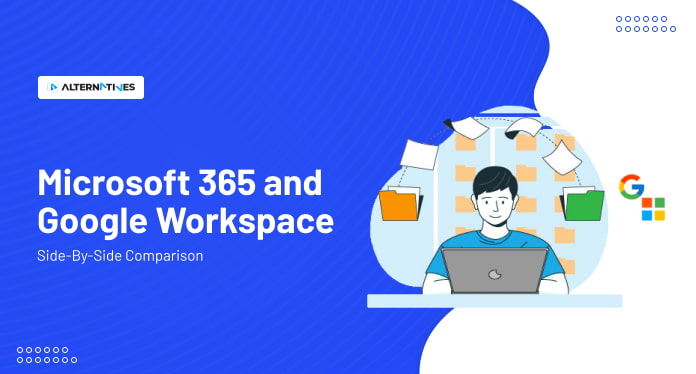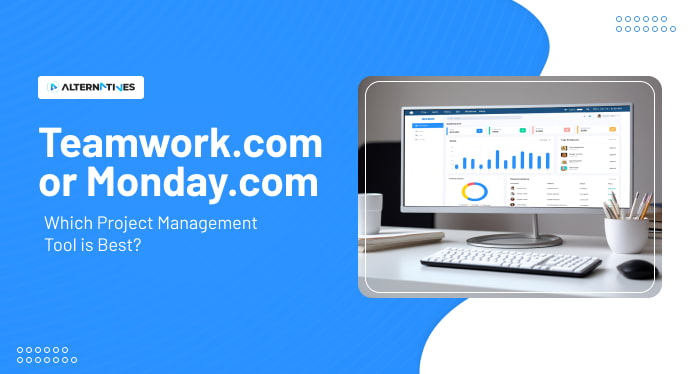Google Workspace vs. Microsoft 365: Side-By-Side Comparison

Choosing between Google Workspace and Microsoft 365 is crucial for productivity. Google Workspace offers seamless collaboration through tools like Google Docs and Drive, while Microsoft 365 provides a robust suite with familiar applications like Word and Excel. Understanding your business needs and preferences is key to making the right choice for efficient communication and collaboration. This blog delves into the comparative analysis of both, evaluating features, collaboration capabilities, and compatibility.
A Quick Overview of Google Workspace
Google Workspace, a comprehensive suite of cloud-based productivity tools, seamlessly integrates communication and collaboration. Featuring Gmail, Google Drive, Docs, Sheets, and Meet, it fosters real-time collaboration and efficient workflow. With user-friendly interfaces and powerful cloud storage, it’s ideal for organizations prioritizing collaboration. Users seeking similar tools can explore Google Workspace alternatives for tailored solutions to meet their specific business needs.
A Quick Overview of Microsoft 365
Microsoft 365, a robust suite of productivity tools, combines familiar applications like Word, Excel, and Outlook with cloud services. Offering features like Teams for communication, SharePoint for collaboration, and OneDrive for secure cloud storage, ensures seamless productivity. Businesses seeking diverse functionalities can explore Microsoft 365 alternatives for tailored solutions that align with their unique requirements.
Feature Comparison For Google Workspace Vs Microsoft 365
| Feature | Google Workspace | Microsoft 365 |
| Gmail offers a user-friendly interface with powerful search and spam protection. | Outlook provides a feature-rich email client with advanced filtering and organizational tools. | |
| Document Collaboration | Google Docs enables real-time collaboration on documents, fostering seamless teamwork. | Microsoft Word, with real-time editing and commenting, promotes collaborative document creation. |
| Spreadsheets | Google Sheets facilitates collaborative data analysis with real-time sharing and editing. | Microsoft Excel provides advanced data analysis tools and extensive formula capabilities. |
| Cloud Storage | Google Drive offers secure cloud storage with easy sharing and access from any device. | OneDrive provides ample cloud storage with file versioning and seamless integration with Windows. |
| Video Conferencing | Google Meet allows for high-quality video meetings with screen sharing and live captioning. | Microsoft Teams offers video conferencing, file sharing, and integrations for efficient collaboration. |
| Calendar | Google Calendar provides intuitive scheduling with event reminders and shared calendars. | Outlook Calendar offers robust scheduling features and integrates seamlessly with other Microsoft apps. |
| Presentation Tools | Google Slides facilitates collaborative presentation creation with real-time editing. | PowerPoint provides powerful presentation features, animations, and design options. |
| Task Management | Google Tasks offers a simple task list with integration across various Google apps. | Microsoft To-Do provides a user-friendly task management tool with integration across Microsoft 365. |
| Offline Access | Google Workspace allows offline access to documents, emails, and calendar events. | Microsoft 365 offers offline access to files and emails through desktop applications. |
| Mobile Apps | Google Workspace apps are available on mobile devices, providing on-the-go productivity. | Microsoft 365 apps are optimized for mobile, offering productivity on smartphones and tablets. |
| Collaborative Chat | Google Chat enables real-time communication within documents for seamless collaboration. | Microsoft Teams includes chat features, allowing users to communicate and collaborate on one platform. |
| Web Analytics | Google Analytics provides insights into website traffic and user behaviour. | Microsoft 365 Analytics helps organizations understand collaboration patterns and usage. |
| Customizable Dashboards | Google Workspace allows users to create personalized dashboards for quick access to information. | Microsoft 365 offers customizable dashboards in apps like Power BI for data visualization. |
| Pricing | Google Workspace offers four different plans starting at $6/month/user with a one-year commitment. The plans are Business Starter, Business Standard, Business Plus, and Enterprise. You can try any of these plans free for 14 days | Microsoft 365 offers a range of plans for home and business use. The plans include basic, standard, premium, and apps for business options with different features, prices, and benefits. The subscription cost for Microsoft 365 is $69.99 per year or $6.99 per month |
| Single Sign-On (SSO) | Google Workspace supports Single Sign-On for secure and efficient user authentication. | Microsoft 365 includes robust Single Sign-On capabilities for seamless access across applications. |
Google Workspace Vs Microsoft 365: Feature Comparison
1. Email
Email features in Google Workspace and Microsoft 365 offer powerful communication solutions. Google Workspace’s Gmail boasts a user-friendly interface with robust search capabilities and effective spam protection. It emphasizes real-time collaboration through shared inboxes. In contrast, Microsoft 365’s Outlook provides a feature-rich email client with advanced filtering and organizational tools, ensuring seamless communication. Both platforms prioritize security and integration, offering distinct but comprehensive email solutions tailored to diverse organizational preferences and requirements.
2. Document Collaboration
Document collaboration in Google Workspace and Microsoft 365 revolutionizes teamwork. Google Workspace’s Docs allows real-time collaboration, fostering simultaneous editing and commenting for efficient content creation. Meanwhile, Microsoft 365’s Word enables collaborative document development with advanced editing and reviewing features. Both platforms emphasize seamless sharing, version control, and accessibility across devices, providing organizations with versatile tools to enhance collaborative work environments.
3. Spreadsheets
The spreadsheet features in Google Workspace and Microsoft 365 redefine data analysis and collaboration. Google Workspace’s Sheets offers real-time collaboration, allowing teams to analyze and edit data simultaneously. With intuitive functions, it simplifies complex calculations. On the other hand, Microsoft 365’s Excel provides powerful data analysis tools, extensive formula capabilities, and seamless integration with other Office applications. Both platforms prioritize user-friendly interfaces, making data manipulation and collaboration efficient, but users may prefer one over the other based on specific requirements and familiarity.
4. Cloud Storage
Cloud storage features in Google Workspace and Microsoft 365 redefine accessibility and data management. Google Workspace’s Drive offers secure cloud storage with effortless sharing, facilitating easy access to files from any device. Meanwhile, Microsoft 365’s OneDrive provides ample cloud storage with file versioning and seamless integration with Windows, ensuring data consistency. Both platforms prioritize data security and collaboration, providing organizations with versatile storage solutions. Choosing between them depends on specific storage needs and integration preferences within existing workflows.
5. Video Conferencing
Video conferencing features in Google Workspace and Microsoft 365 redefine virtual collaboration. Google Workspace’s Meet enables high-quality video meetings with screen sharing and live captioning, emphasizing real-time communication. On the other hand, Microsoft 365’s Teams offers a comprehensive platform with video conferencing, file sharing, and integrations, providing an integrated collaboration hub. Both platforms prioritize seamless virtual interactions, allowing organizations to choose based on specific needs and preferences for features, integration, and user experience.
6. Calendar
The calendar features in Google Workspace and Microsoft 365 elevate schedule management. Google Workspace’s Calendar provides an intuitive scheduling platform with event reminders and shared calendars, emphasizing simplicity and accessibility. In contrast, Microsoft 365’s Outlook Calendar offers robust scheduling features, seamlessly integrating with other Microsoft applications for a unified experience. Both platforms prioritize efficient time management, offering organizations versatile tools to enhance productivity, with the choice depending on specific preferences and integration within existing workflows.
7. Presentation Tools
The presentation tools in Google Workspace and Microsoft 365 redefine collaborative storytelling. Google Workspace’s Slides facilitate real-time collaborative presentations, emphasizing teamwork and creativity. In contrast, Microsoft 365’s PowerPoint provides powerful features, animations, and design options, allowing for dynamic and engaging presentations. Both platforms prioritize seamless collaboration, offering organizations versatile tools to convey ideas effectively. The choice between them depends on specific presentation needs and preferences for features, integration, and user experience.
8. Task Management
Task management features in Google Workspace and Microsoft 365 redefine productivity. Google Workspace’s Tasks offers a simple and integrated task list that syncs across various apps, enhancing efficiency. Conversely, Microsoft 365’s To-Do provides a user-friendly task management tool with seamless integration across the suite, ensuring a cohesive workflow. Both platforms prioritize organized task tracking, offering organizations versatile tools to manage work effectively. The choice between them depends on specific preferences and integration requirements within existing workflows.
9. Offline Access
Google Workspace allows offline access to documents, emails, and calendar events, ensuring seamless work without an internet connection. In contrast, Microsoft 365 offers offline access to files and emails through desktop applications, enabling users to stay productive even in areas with limited connectivity. Both platforms prioritize accessibility, providing organizations with versatile tools to work efficiently in various environments. The choice depends on specific offline work preferences and integration within workflows.
10. Mobile Access
Google Workspace apps are optimized for mobile devices, ensuring users can stay productive anywhere. Meanwhile, Microsoft 365 apps offer seamless functionality on smartphones and tablets, providing a consistent user experience. Both platforms prioritize mobile accessibility, offering organizations versatile tools to work efficiently while away from the desk. The choice depends on specific mobile preferences and integration requirements within existing workflows.
11. Collaborative Chat
Collaborative chat features in Google Workspace and Microsoft 365 redefine real-time communication. Google Chat enables seamless conversations within documents, fostering collaborative discussions. On the other hand, Microsoft 365’s Teams offers a comprehensive chat platform, allowing users to communicate and collaborate in one centralized space. Both platforms prioritize efficient communication, providing organizations with versatile tools to enhance teamwork. The choice depends on specific preferences and integration requirements within existing workflows for a cohesive and collaborative chat experience.
12. Web Analytics
Web analytics features in Google Workspace and Microsoft 365 empower organizations to gain valuable insights. Google Analytics, integrated into Workspace, offers comprehensive data on website traffic and user behaviour, aiding informed decision-making. In contrast, Microsoft 365 Analytics provides insights into collaboration patterns, document usage, and user engagement within the suite. Both platforms prioritize data-driven decision-making, offering organizations versatile tools to optimize their online presence or internal collaboration strategies, depending on specific needs and preferences.
13. Customizable Dashboards
Customizable dashboards in Google Workspace and Microsoft 365 elevate data visualization and accessibility. Google Workspace allows users to create personalized dashboards for quick access to information, fostering a tailored and efficient work environment. In contrast, Microsoft 365 offers customizable dashboards within apps like Power BI, providing robust data visualization tools for comprehensive insights. Both platforms prioritize personalized user experiences, offering organizations versatile tools to enhance decision-making and streamline workflows based on specific preferences and integration requirements.
14. Pricing
Google Workspace and Microsoft 365 offer a range of plans for home and business use. If we look at Google Workspace's pricing it has four plans: Business Starter ($6/user/month), Business Standard ($12/user/month), Business Plus ($18/user/month), and Enterprise (customizable). Microsoft 365 has three plans: Basic ($69.99/year or $6.99/month), Standard, and Premium. The pricing for Microsoft 365 plans varies based on the features and benefits offered. You can compare all the plans and pricing on the respective websites. Both services offer a free trial period of 14 days.
15. Single Sign-On
Single Sign-On (SSO) features in Google Workspace and Microsoft 365 streamline user authentication for enhanced security. Google Workspace supports SSO, allowing users to access various applications with a single set of credentials, promoting efficiency and minimizing security risks. Similarly, Microsoft 365 includes robust SSO capabilities, ensuring seamless access across its suite of applications. Both platforms prioritize user convenience and security, offering organizations versatile tools to manage authentication efficiently based on specific preferences and integration requirements.
Google Workspace Vs Microsoft 365 – Which is Better?
In the dynamic landscape of productivity suites, the choice between Google Workspace and Microsoft 365 is a critical decision that businesses must navigate. Each platform brings its unique strengths and features to the table, catering to different organizational needs and user preferences.
Moreover, in our review of Google Workspace, we find it offers a user-friendly and accessible platform for collaborative work, with tools like Google Docs and Google Sheets. Whereas in the Microsoft 365 review, it's evident that the platform excels in providing comprehensive solutions. It boasts robust security measures, and extensive collaboration tools like SharePoint Online, Skype, etc.
Why Google Workspace is Better:
- Real-Time Collaboration: Google Workspace excels in fostering real-time collaboration, allowing multiple users to work simultaneously on documents, spreadsheets, and presentations.
- Cloud-Centric: With a strong emphasis on cloud-based solutions, Google Workspace provides seamless access to files and applications from any device, promoting flexibility and remote work.
- Simplified User Interface: Google Workspace features user-friendly interfaces in applications like Gmail, Docs, and Sheets, making it easy for users to adapt quickly and navigate effortlessly.
- Integration with Google Services: Seamless integration with Google’s ecosystem, including Google Drive, Gmail, and Calendar, enhances overall productivity.
Why Microsoft 365 is Better:
- Robust Desktop Applications: Microsoft 365 offers powerful desktop applications such as Word, Excel, and PowerPoint, providing comprehensive features and capabilities for document creation and editing.
- Integration with Windows Ecosystem: Ideal for organizations heavily invested in the Windows ecosystem, Microsoft 365 ensures seamless integration with Windows devices and services.
- Advanced Security Measures: Microsoft 365 incorporates advanced security features, making it a preferred choice for organizations with stringent security and compliance requirements.
- Extensive Third-Party App Support: Microsoft 365 supports a wide range of third-party applications, offering users flexibility and extended functionalities.
Frequently Asked Questions
What is Google Workspace?
Google Workspace is a cloud-based productivity suite that includes Gmail, Google Drive, Google Docs, Google Sheets, Google Slides, and more. It is designed to help businesses of all sizes collaborate more effectively and efficiently.
What is Microsoft 365?
Microsoft 365 is a cloud-based productivity suite that includes Word, Excel, PowerPoint, Outlook, OneNote, OneDrive, and more. It is designed to help businesses of all sizes collaborate more effectively and efficiently.
What are the differences between Google Workspace and Microsoft 365?
Google Workspace and Microsoft 365 have similar features and benefits, but there are some differences. For example, Google Workspace is known for its ease of use and collaboration features, while Microsoft 365 is known for its powerful desktop applications and integration with Windows
What are the features offered by Google Workspace?
It offers custom business email, cloud storage, 24/7 phone and email support, and administrative controls for user accounts. Some of the most popular applications included in Google Workspace are Gmail, Google Drive, Google Docs, Google Sheets, Google Slides, Google Calendar, Google Meet, and Google Forms.
What are the features offered by Microsoft 365?
Microsoft 365 offers a range of features for home and business use, including Word, Excel, PowerPoint, Outlook, OneNote, OneDrive, Teams, Forms, Stream, and more. You can compare all the plans and pricing on the Microsoft website.
Conclusion
In conclusion, the choice between Google Workspace and Microsoft 365 hinges on organizational priorities and preferences. Google Workspace offers a cloud-centric, collaboration-focused approach, while Microsoft 365 emphasizes robust desktop applications and integration with the Windows ecosystem. The decision should align with the unique needs of a business, considering factors like collaboration style, existing infrastructure, and overall usability.



